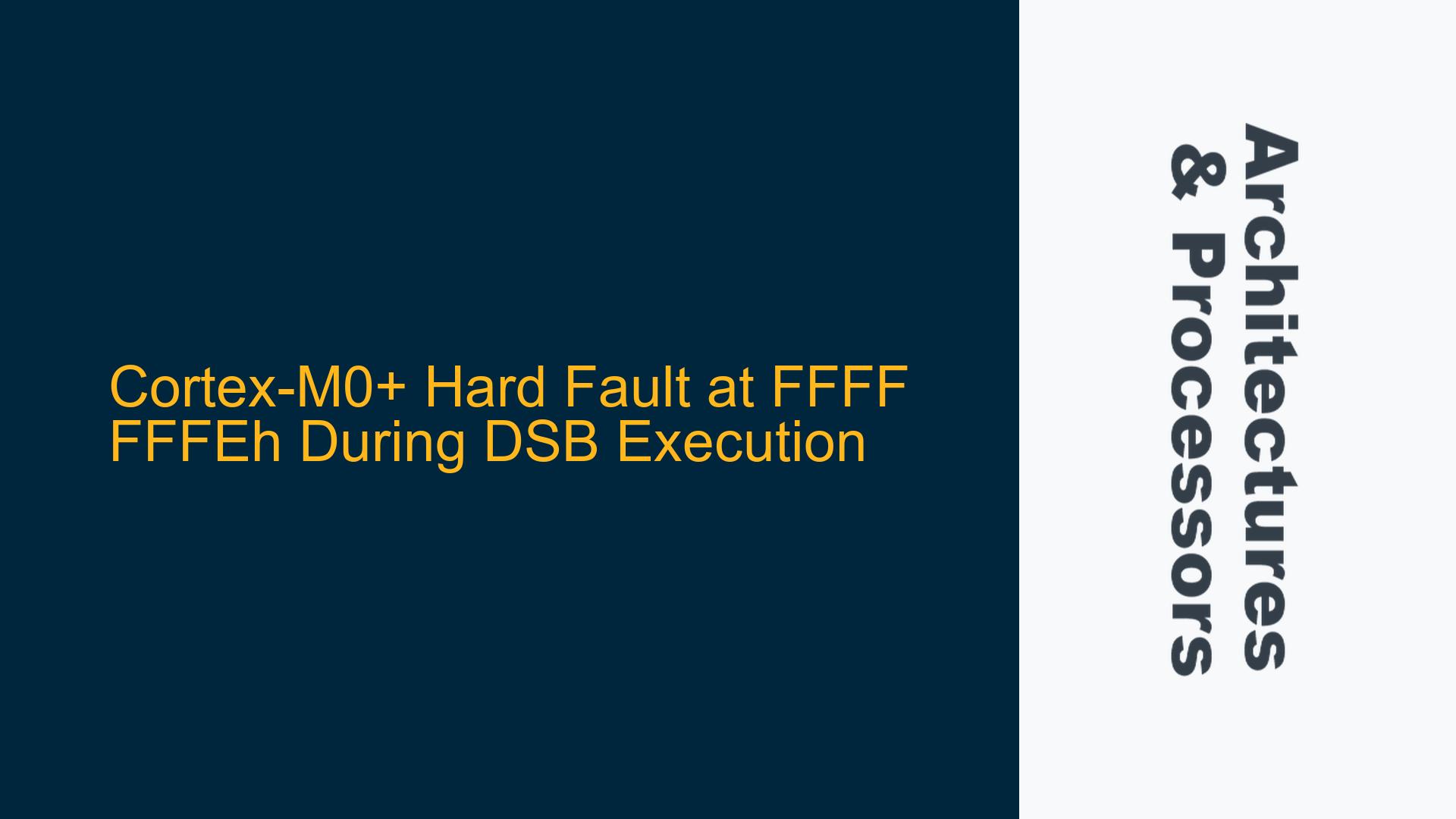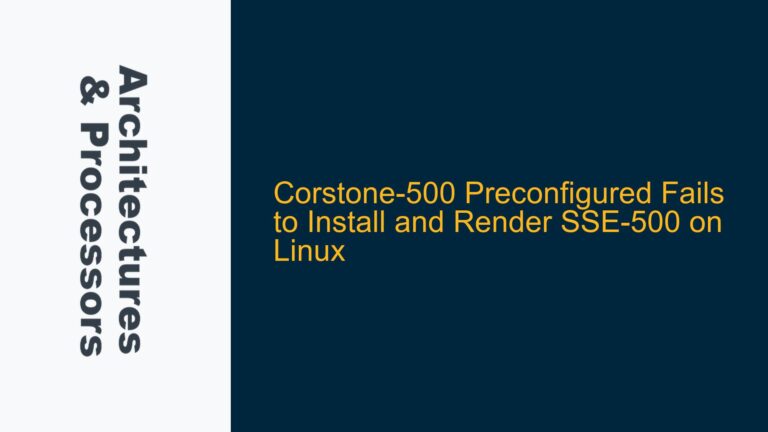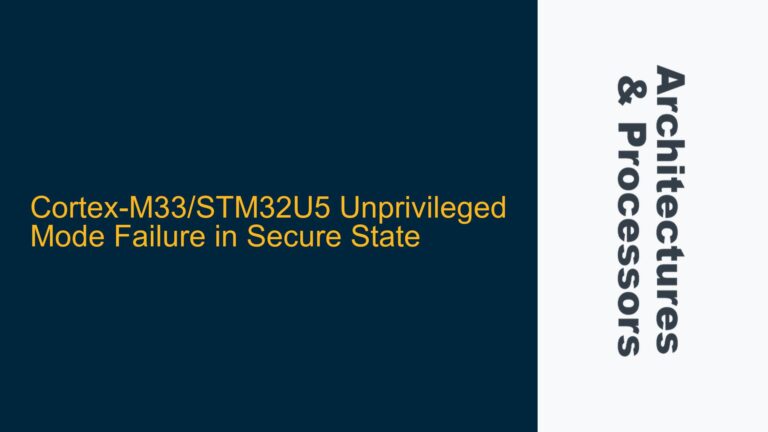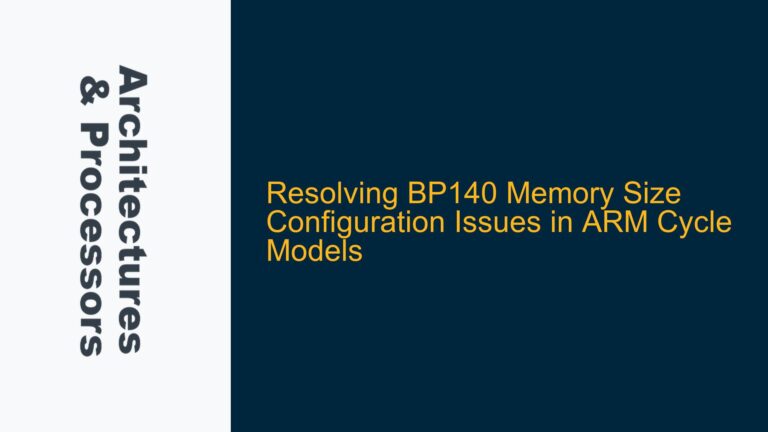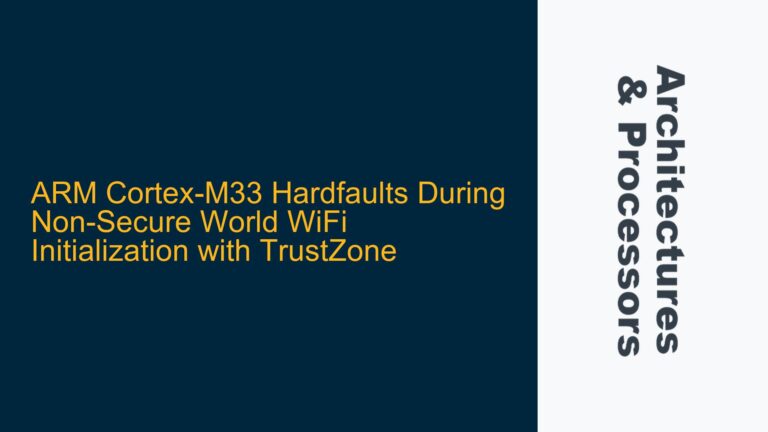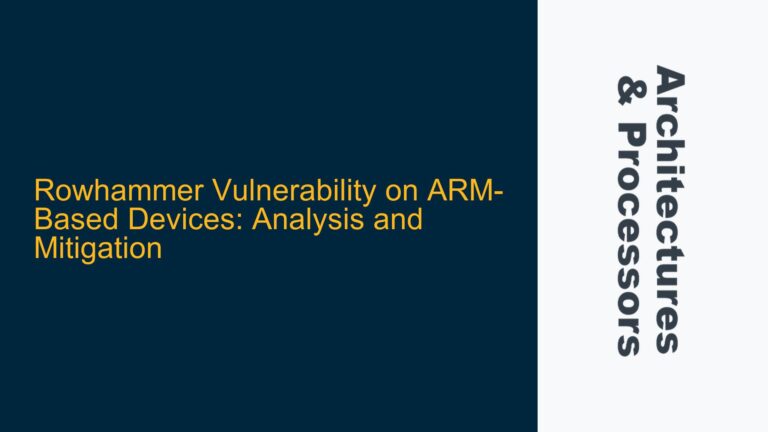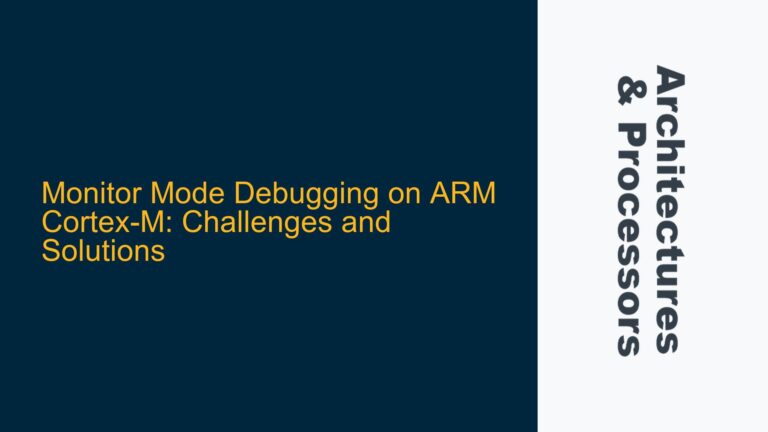Cortex-M0+ Hard Fault Triggered by DSB Instruction at FFFF FFFEh
The Cortex-M0+ processor is a popular choice for embedded systems due to its simplicity, low power consumption, and cost-effectiveness. However, its reduced instruction set and lack of certain features compared to higher-end Cortex-M processors can lead to subtle issues, especially when porting software like FreeRTOS. One such issue is the occurrence of a Hard Fault when executing the Data Synchronization Barrier (DSB) instruction, resulting in the Program Counter (PC) showing an address of FFFF FFFEh and the Exception (Exc) value of the xPSR register being 0x03. This behavior is particularly perplexing because the Hard Fault handler is not located at FFFF FFFEh, and the issue only manifests at optimization level -O0 in GCC.
DSB Instruction and Cortex-M0+ Architecture Constraints
The DSB instruction is used to ensure that all memory accesses are completed before proceeding to the next instruction. This is crucial in scenarios where the order of memory operations must be strictly controlled, such as during context switching in an RTOS or when configuring peripherals. However, the Cortex-M0+ processor, being based on the ARMv6-M architecture, has a limited instruction set and does not natively support the DSB instruction. Instead, the DSB instruction is treated as a NOP (No Operation) on the Cortex-M0+. This means that any attempt to use DSB on a Cortex-M0+ should, in theory, have no effect.
The fact that the Cortex-M0+ is hanging at FFFF FFFEh when executing the DSB instruction suggests that there is an underlying issue that is not immediately apparent. The address FFFF FFFEh is not a valid memory location in the Cortex-M0+ address space, and the fact that the PC is pointing to this address indicates that the processor has encountered an exception that it cannot handle properly. The Exc value of 0x03 in the xPSR register further confirms that a Hard Fault has occurred.
Optimization Level Dependency and Compiler Behavior
The issue’s dependency on the GCC optimization level (-O0) is particularly noteworthy. At -O0, the compiler generates code with minimal optimizations, which can lead to different instruction sequences and memory access patterns compared to higher optimization levels. This suggests that the problem may be related to how the compiler generates code for the DSB instruction at different optimization levels. At higher optimization levels, the compiler might be optimizing away the DSB instruction or rearranging instructions in a way that avoids the issue.
The Cortex-M0+ processor’s handling of the DSB instruction as a NOP could be interacting with the compiler’s code generation in unexpected ways. For example, the compiler might be generating code that assumes certain behavior from the DSB instruction, which is not actually supported by the Cortex-M0+. This mismatch between the compiler’s expectations and the processor’s actual behavior could be leading to the Hard Fault.
Memory Map and Exception Handling in Cortex-M0+
The Cortex-M0+ processor has a fixed memory map, with specific address ranges reserved for code, data, peripherals, and the system control space. The address FFFF FFFEh is not part of any valid memory region in the Cortex-M0+ memory map. When the processor encounters an exception, it should vector to the appropriate exception handler based on the exception vector table. However, in this case, the PC is pointing to FFFF FFFEh, which suggests that the exception handling mechanism has failed in some way.
The Hard Fault exception is typically triggered by serious errors such as accessing invalid memory locations, executing undefined instructions, or attempting to execute code from a non-executable memory region. In this case, the Hard Fault is being triggered by the DSB instruction, which should not normally cause an exception. This indicates that there may be an issue with the way the DSB instruction is being handled by the processor or the way the compiler is generating code for it.
Potential Causes of the Hard Fault
Incorrect Compiler Flags or Toolchain Configuration
One possible cause of the issue is incorrect compiler flags or toolchain configuration. The Cortex-M0+ processor has specific requirements for compiler flags, particularly when it comes to handling instructions that are not natively supported, such as DSB. If the compiler is not configured correctly, it might generate code that assumes the presence of certain instructions or features that are not available on the Cortex-M0+. This could lead to the generation of invalid code sequences that cause the processor to hang or trigger a Hard Fault.
Misalignment of Memory Accesses
Another potential cause is misaligned memory accesses. The Cortex-M0+ processor does not support unaligned memory accesses, and attempting to perform such accesses can result in a Hard Fault. If the DSB instruction is being used in a context where it is expected to synchronize memory accesses, and those accesses are misaligned, this could lead to a Hard Fault. The fact that the issue only occurs at -O0 optimization level suggests that the compiler might be generating code that inadvertently causes misaligned memory accesses at this optimization level.
Incorrect Exception Vector Table Configuration
The exception vector table in the Cortex-M0+ processor must be correctly configured to handle exceptions such as Hard Faults. If the vector table is not correctly set up, the processor might not be able to properly handle exceptions, leading to undefined behavior such as the PC pointing to an invalid address like FFFF FFFEh. This could be exacerbated by the use of the DSB instruction, which might be causing the processor to enter an unexpected state that the exception handling mechanism cannot properly resolve.
Interaction with FreeRTOS and Context Switching
The issue is occurring during the porting of FreeRTOS to the Cortex-M0+ device, which suggests that the problem might be related to the interaction between the DSB instruction and the RTOS’s context switching mechanism. FreeRTOS uses the DSB instruction to ensure that memory operations are completed before switching contexts. If the DSB instruction is not being handled correctly by the Cortex-M0+, this could lead to issues during context switching, resulting in a Hard Fault. The fact that the issue only occurs at -O0 optimization level might be related to how the compiler generates code for the context switching routines at different optimization levels.
Troubleshooting and Resolving the Hard Fault Issue
Verify Compiler Flags and Toolchain Configuration
The first step in troubleshooting this issue is to verify that the compiler flags and toolchain configuration are correct for the Cortex-M0+ processor. This includes ensuring that the correct architecture (-mcpu=cortex-m0plus) and instruction set (-mthumb) are specified. Additionally, the compiler should be configured to generate code that is compatible with the Cortex-M0+’s limited instruction set. This might involve disabling certain optimizations or enabling specific flags that ensure compatibility with the Cortex-M0+.
Check for Misaligned Memory Accesses
Next, it is important to check for misaligned memory accesses in the code. This can be done by reviewing the code for any instances where memory accesses might be misaligned, particularly in the context of the DSB instruction. Tools such as static analyzers or runtime checks can be used to identify potential misaligned memory accesses. If misaligned accesses are found, they should be corrected to ensure that all memory accesses are properly aligned.
Validate Exception Vector Table Configuration
The exception vector table should be reviewed to ensure that it is correctly configured for the Cortex-M0+ processor. This includes verifying that the Hard Fault handler is correctly specified in the vector table and that the vector table is located at the correct address in memory. Additionally, the vector table should be checked for any potential issues that might prevent the processor from correctly handling exceptions.
Investigate FreeRTOS Context Switching Code
The FreeRTOS context switching code should be reviewed to ensure that it is correctly using the DSB instruction. This includes verifying that the DSB instruction is being used in the correct context and that it is not being used in a way that might cause issues on the Cortex-M0+. If necessary, the context switching code should be modified to ensure compatibility with the Cortex-M0+’s limited instruction set.
Use Debugging Tools to Analyze the Issue
Debugging tools such as JTAG debuggers or software debuggers can be used to analyze the issue in more detail. This includes setting breakpoints at the DSB instruction and stepping through the code to observe the processor’s behavior. Additionally, the debugger can be used to inspect the contents of the PC, xPSR, and other registers to gain more insight into the cause of the Hard Fault.
Consider Alternative Synchronization Mechanisms
If the issue cannot be resolved by modifying the code or toolchain configuration, it may be necessary to consider alternative synchronization mechanisms that do not rely on the DSB instruction. For example, the Cortex-M0+ supports the use of the __sync_synchronize() intrinsic, which can be used to achieve memory synchronization without relying on the DSB instruction. This intrinsic generates a sequence of instructions that achieve the same effect as the DSB instruction but are compatible with the Cortex-M0+’s instruction set.
Conclusion
The Cortex-M0+ processor’s handling of the DSB instruction can lead to subtle issues, particularly when porting software like FreeRTOS. The occurrence of a Hard Fault at FFFF FFFEh when executing the DSB instruction is a complex issue that requires careful analysis of the compiler flags, memory accesses, exception vector table, and context switching code. By following the troubleshooting steps outlined above, it is possible to identify and resolve the underlying cause of the issue, ensuring that the Cortex-M0+ processor operates correctly in the context of the FreeRTOS environment.
